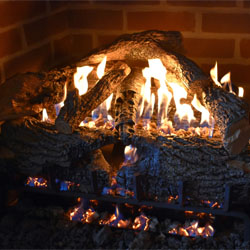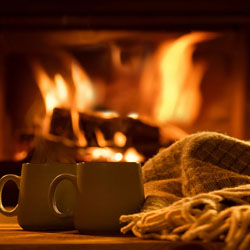


1100 S.E. Loop 7
Athens, Texas
FAQ

It is very important to clean your glass after the initial 3 hours of burn time. Failure to do so can cause permanent etching of your glass.
A pilot light will burn 800 to 1500 BTUs/hr. Your monthly gas bill should include your exact cost per "therm" (100,000 BTUs). Based on this rate you can calculate the cost for your area to operate a pilot light.
Zero clearance has two meanings. The first is whether or not the fireplace can be placed on a floor without footings. The second meaning of zero clearance is if you are able to finish up to the face of the fireplace, so that no metal shows after installation is complete.

Proper sizing is determined by the size of the fireplace base and the overall size of the Gas Log and Hearth Kit, which requires measuring the front width, back width, depth and height of the fireplace. Getting logs or controls too tight to the sides can cause damage to the fireplaces and gas logs controls.
A damper clamp will come standard with your gas log set and MUST be installed to maintain a small opening at all times. This allows for the escape of any pilot exhaust. When the logs are in use the damper must be fully open.
Never, ever wash your logs. Remove the logs carefully from the fireplace in a box, take them outside and use a soft brush or vacuum to clean them. Make sure you replace the logs exactly as they were originally placed.

You want to make sure that your fireplace is ready to use safely. You can follow these tips to get your fireplace ready for use:
There may be a few other things you have to do, but these steps will help get you on the right track to a safe fireplace. Make sure you hire a professional to inspect your chimney because they will know exactly what to look for, and they will be able to keep your family and home as safe as possible. Be sure to ask these professionals about what warning signs to look for and for proper maintenance and usage tips.
For any other questions visit: https://www.heatilator.com/owner-support/troubleshooting-and-faqs/common-questions.

1100 S.E. Loop 7, Athens, Texas
1-903-675-9229
Larry@fieldstoneandfireplaces.com
Monday-Thursday: 8-4
Friday: 8-2
Saturday: By Appointment Only
Sunday: Closed
All Stone Sales are Final No Returns!